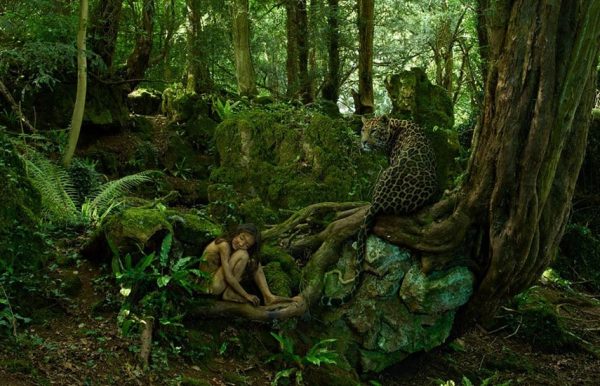The concept of feral children, those who have lived isolated from human contact from a very young age and have been raised by animals, has been a topic of fascination and intrigue for centuries. The stories of these children, often found living with animals such as dogs, monkeys, and wolves, challenge our understanding of human nature, behavior, and the boundaries between humans and animals. This post will delve into the lives of several children who were raised by animals, exploring their unique stories and the broader implications of their experiences.
Contents
- 1 The Phenomenon Of Feral Children
- 2 Ugandan Monkey Boy: John Ssebunya
- 3 Cambodian Jungle Girl: Rochom P’ngieng
- 4 Lobo Wolf Girl Of Devils River
- 5 Russian Bird Boy
- 6 Amala And Kamala: The Wolf Girls Of India
- 7 Peter The Wild Boy: The Feral Child Of Germany
- 8 Reflect On The Lives Of Children Who Were Raised By Animals
The Phenomenon Of Feral Children

Feral children, often described as children who have lived in isolation from human contact and have been raised by animals, present a unique perspective on human development. Having spent their formative years in the company of animals, these children often exhibit behaviors and characteristics more commonly associated with the species that raised them. This phenomenon raises intriguing questions about the nature versus nurture debate and the extent to which your environment shapes your behavior and identity.
The psychological and sociological implications of feral children are profound. These children often face significant challenges in learning human language and social norms, and their cognitive development is typically affected. The study of feral children provides valuable insights into the human capacity for adaptation and survival and the potential for cross-species empathy and care. In the following sections, you will get a closer look at some of the most well-known cases of feral children and explore their unique stories.
Ugandan Monkey Boy: John Ssebunya

John Ssebunya’s life took a dramatic turn at the age of four when he witnessed a horrifying event: the murder of his mother by his father. Traumatized, John fled into the Ugandan jungle, where he was reportedly taken in by a troop of vervet monkeys. These monkeys became his family, providing him with food and teaching him survival skills as he adapted to their way of life.
John’s story took another turn in 1991 when villagers discovered him living with the monkeys. As is often the case with feral children, John resisted capture, and his adoptive monkey family even attempted to protect him by throwing sticks at his captors. Since his capture, John has learned to speak and even to sing. He now tours with the Pearl of Africa children’s choir, showcasing a remarkable transformation from his early years in the jungle.
Cambodian Jungle Girl: Rochom P’ngieng

The story of Rochom P’ngieng, often referred to as the Cambodian Jungle Girl, is one of survival against all odds. At the tender age of 8, while herding buffalo along the edge of the jungle, Rochom mysteriously disappeared. For the next eighteen years, she lived in the dense jungle, surviving on her own, far from human civilization.
In 2007, almost two decades after her disappearance, a villager caught sight of a naked woman attempting to steal rice from his property. Identified by a distinctive scar on her back, Rochom had grown into a 30-year-old woman who had somehow managed to survive in the harsh jungle environment. Despite attempts to reintegrate her into society, Rochom was unable to adapt to the local culture and language, and in May 2010, she chose to return to the wild, the place she had called home for the majority of her life.
Lobo Wolf Girl Of Devils River

In 1845, near San Felipe, Mexico, a mysterious girl was spotted running on all fours in the company of wolves, attacking a herd of goats. This sighting was corroborated a year later when the girl was seen again, this time devouring a freshly killed goat. The local villagers, alarmed by these sightings, mounted a search for the girl and eventually captured her. However, her connection to the wild was not easily severed.
The girl, known as the Lobo Wolf Girl of Devil’s River, howled incessantly throughout the night of her capture, attracting a pack of wolves that charged into the village in an apparent rescue attempt. Seizing the opportunity, she escaped her enclosure and disappeared. She was sighted once more in 1852, suckling two wolf cubs on a river sandbar. After this sighting, she vanished into the woods and was never heard from again, leaving behind a story shrouded in mystery and intrigue.
Russian Bird Boy

The story of the Russian Bird Boy is a stark reminder of the impact of extreme neglect and abuse on a child’s development. Raised in a room filled with bird cages, the boy was treated more like a pet bird than a human child by his mother. His only companions were the birds around him, and he began to mimic their behavior, chirping instead of speaking and displaying other bird-like behaviors.
When the boy was discovered, he was physically healthy but showed significant social and cognitive impairments. He was unable to engage in any form of human communication; instead, he communicated as his bird companions did. The boy has since been moved to a center for psychological care, where professionals are working tirelessly to rehabilitate him and teach him basic human communication and social skills. His story underscores the critical importance of early childhood socialization in human development.
Amala And Kamala: The Wolf Girls Of India

In 1920, in Midnapore, India, two girls were discovered living in a wolves’ den. The girls, Amala and Kamala, aged 8 years and 18 months, respectively, were believed to have been taken by wolves on separate occasions. Their story is one of the most intriguing and controversial among documented cases of feral children. Living with the wolves, they had adopted many of their behaviors, further blurring the line between human and animal behavior.
Despite attempts to reintegrate them into human society, Amala and Kamala reportedly longed to return to the wild. They struggled to adapt to the civilized world, a testament to the profound impact of their early experiences. Their story raises poignant questions about identity, belonging, and the deep-seated instincts that drive us.
Peter The Wild Boy: The Feral Child Of Germany

In 1724, a naked, hairy boy walking on all fours emerged from the woods near Hamelin, Germany. The boy, who behaved more like a wild animal than a human, was eventually captured and given the name Peter the Wild Boy. Peter’s diet consisted of birds and vegetables, which he preferred to eat raw, and he was incapable of speaking. His story provides a stark contrast to the civilized world and offers a glimpse into a life lived entirely in the wild.
Peter was moved to England, where he was taught menial tasks and developed a love for music. Despite these efforts, he never learned to talk, highlighting the critical role of early childhood in language acquisition. Peter lived to an advanced age, a testament to his resilience and adaptability. His story continues to captivate, offering valuable insights into human behavior and development.
Reflect On The Lives Of Children Who Were Raised By Animals
The stories of children raised by animals challenge your understanding of what it means to be human. They provide a unique lens through which to view the human condition, offering insights into the fundamental aspects of human nature, behavior, and development. While these stories are often tinged with tragedy and hardship, they also speak to the remarkable resilience of the human spirit and the profound connections that can form between humans and animals. As you reflect on these extraordinary lives, you should be reminded of the importance of compassion, understanding, and respect for all forms of life.


